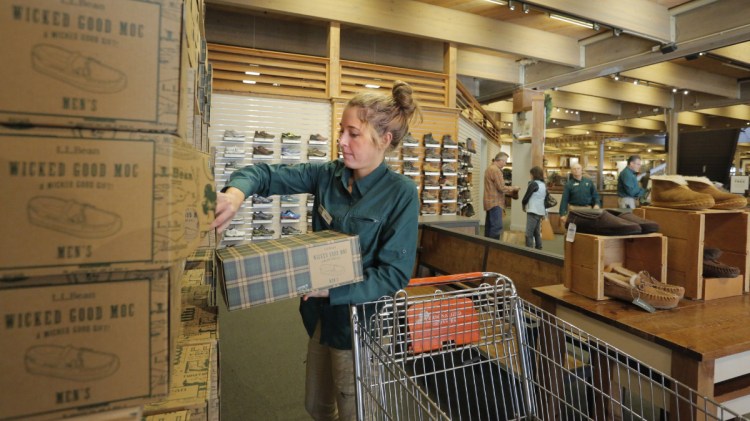Maine’s workforce crisis is pushing the tourism industry to take extra steps to find enough seasonal workers.
The Maine Tourism Association soon will start a staffing service to connect its members with job seekers in Maine and other parts of the country.
“We’ve seen year after year of successful tourism seasons, and Maine unemployment hovers around 3 percent. These are great pieces of news, but it does mean that there is demand for employees that can’t be met with Maine workers alone,” Chris Fogg, executive director of the tourism association, said in a news release.
In recent years, restaurants, hotels and attractions have had to shut down early or reduce hours during the peak summer season because they did not have enough workers. The problem is acute on Maine’s coast, the state’s most popular tourism destination with a local seasonal workforce deficit.
“At some point, the concern is that labor shortages start impacting the visitor experience negatively,” Fogg said in an interview. “If you don’t have enough people to operate, you can’t give people the experience they expect.”

Susan Works, right, and other workers fill seed orders at Johnny’s Selected Seeds.
His group plans to bring on a full-time staff member to find employees in other states, provide background checks, arrange transportation to Maine and offer basic hospitality skills training.
One target is seasonal workers in the western ski industry, such as in Colorado or Utah, or those working winter break hotspots in Florida who could be convinced to transfer to Maine for the summer season. The approach is similar to the one that some Maine companies have taken with counterparts in other states, but the association wants to formalize those relationships, Fogg said.
The staffing service also will try to pair Maine businesses that have complementary labor needs and can “share” workers from peak winter and summer seasons.
A WORSENING PROBLEM
A pilot program will run through 2019 for a handful of businesses before the association expands it to all of its 1,500 members, Fogg said.
“I don’t think our idea is going to solve the problem, but it is going to contribute to helping solve it,” he said.

Louise Ellis fills gallon jugs with fresh cider at the Hope Orchard in 2017.
Maine had 36.7 million tourist visits in 2017 and tourists spent about $6 billion, a five-year high, according to estimates from the Maine Office of Tourism. Around 106,800 people are employed directly and indirectly in the tourism industry, which includes lodging, restaurants and food service, retail, entertainment and other businesses.
With so many sectors represented, it is difficult to determine how many jobs go unfilled on a seasonal basis, but it is definitely an issue, said state economist Glenn Mills. The shortage is worse because people who worked seasonally in the past have found year-round employment, and there are fewer young people to fill the seasonal jobs, Mills said. A strict cap on the number of H-2B visas for temporary foreign workers, a program that Maine businesses have relied on to supplement local workers, has exacerbated the problem, he said.
EBB AND FLOW OF WORKERS
Seasonal labor makes up a big proportion of the state’s tourism industry.
From July to September last year, Maine’s accommodations and food services industry employed 69,650 people, a 44 percent increase from the beginning of the year. The workforce contracted to almost 55,000 employees in the fall and early winter, a pattern from previous years, according to Maine Department of Labor statistics. Arts, entertainment and recreation businesses had similar seasonal growth, rising from around 8,000 employees in the winter to more than 11,000 during the height of summer.

Angel Gonzalez shovels leaves into a trailer at Sebasco Harbor Resort this year.
The Maine Department of Labor has encouraged businesses to hire teens to help meet the labor shortfall, and last year Gov. Paul LePage suggested low-risk prison inmates could receive conditional commutations to help fill vacancies.
OPTIMISM, OTHER OBSTACLES
Laura Dolce, executive director of the Kennebunk-Kennebunkport-Arundel Chamber of Commerce, said she is “cautiously optimistic” that the tourism association’s initiative is a sign of momentum to address the persistent labor shortage. Workforce issues were a major theme of last year’s governor’s conference on tourism, but Dolce felt like nothing came out of it.
“I think we’re still too early to tell, it is good there are conversations,” she said. If the tourism association can bring in new seasonal workers, Dolce said, it still will have to confront expensive coastal housing and poor public transportation that create barriers for people who might take seasonal jobs.
“I think it is great they are going to have a staff member to bring workers in, but in order to make any of that meaningful, we have to address those two infrastructure issues,” she said.
Peter McGuire can be contacted at 791-6325 or at:
pmcguire@pressherald.com
Twitter: PeteL_McGuire
Send questions/comments to the editors.



Comments are no longer available on this story